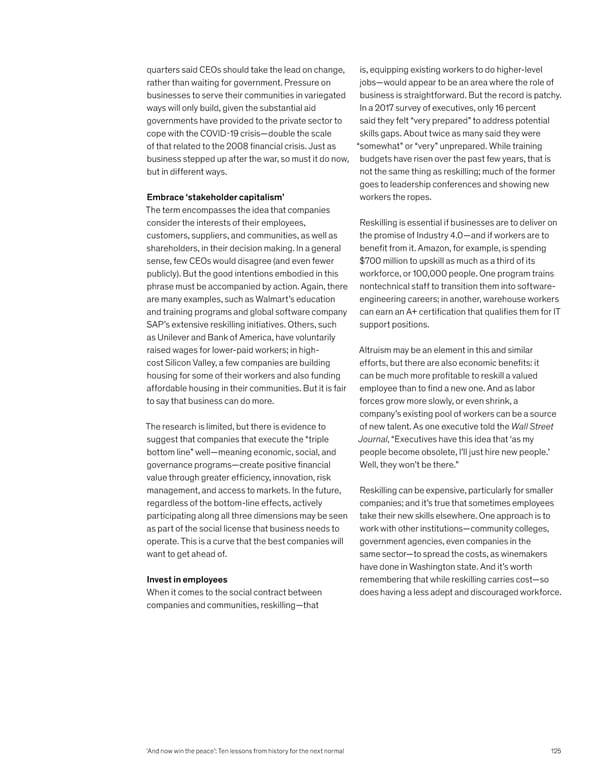quarters said CEOs should take the lead on change, is, equipping existing workers to do higher-level rather than waiting for government. Pressure on jobs—would appear to be an area where the role of businesses to serve their communities in variegated business is straightforward. But the record is patchy. ways will only build, given the substantial aid In a 2017 survey of executives, only 16 percent governments have provided to the private sector to said they felt “very prepared” to address potential cope with the COVID-19 crisis—double the scale skills gaps. About twice as many said they were of that related to the 2008 financial crisis. Just as “somewhat” or “very” unprepared. While training business stepped up after the war, so must it do now, budgets have risen over the past few years, that is but in different ways. not the same thing as reskilling; much of the former goes to leadership conferences and showing new Embrace ‘stakeholder capitalism’ workers the ropes. The term encompasses the idea that companies consider the interests of their employees, Reskilling is essential if businesses are to deliver on customers, suppliers, and communities, as well as the promise of Industry 4.0—and if workers are to shareholders, in their decision making. In a general benefit from it. Amazon, for example, is spending sense, few CEOs would disagree (and even fewer $700 million to upskill as much as a third of its publicly). But the good intentions embodied in this workforce, or 100,000 people. One program trains phrase must be accompanied by action. Again, there nontechnical staff to transition them into software- are many examples, such as Walmart’s education engineering careers; in another, warehouse workers and training programs and global software company can earn an A+ certification that qualifies them for IT SAP’s extensive reskilling initiatives. Others, such support positions. as Unilever and Bank of America, have voluntarily raised wages for lower-paid workers; in high- Altruism may be an element in this and similar cost Silicon Valley, a few companies are building efforts, but there are also economic benefits: it housing for some of their workers and also funding can be much more profitable to reskill a valued affordable housing in their communities. But it is fair employee than to find a new one. And as labor to say that business can do more. forces grow more slowly, or even shrink, a company’s existing pool of workers can be a source The research is limited, but there is evidence to of new talent. As one executive told the Wall Street suggest that companies that execute the “triple Journal, “Executives have this idea that ‘as my bottom line” well—meaning economic, social, and people become obsolete, I’ll just hire new people.’ governance programs—create positive financial Well, they won’t be there.” value through greater efficiency, innovation, risk management, and access to markets. In the future, Reskilling can be expensive, particularly for smaller regardless of the bottom-line effects, actively companies; and it’s true that sometimes employees participating along all three dimensions may be seen take their new skills elsewhere. One approach is to as part of the social license that business needs to work with other institutions—community colleges, operate. This is a curve that the best companies will government agencies, even companies in the want to get ahead of. same sector—to spread the costs, as winemakers have done in Washington state. And it’s worth Invest in employees remembering that while reskilling carries cost—so When it comes to the social contract between does having a less adept and discouraged workforce. companies and communities, reskilling—that ‘And now win the peace’: Ten lessons from history for the next normal 125
 What Now? Page 126 Page 128
What Now? Page 126 Page 128